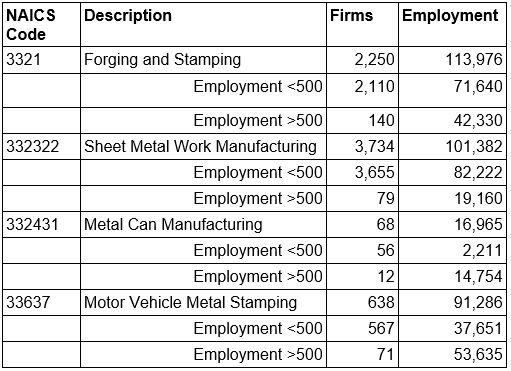President
- FMA
- The Fabricator
- FABTECH
- Canadian Metalworking
Categories
- Additive Manufacturing
- Aluminum Welding
- Arc Welding
- Assembly and Joining
- Automation and Robotics
- Bending and Forming
- Consumables
- Cutting and Weld Prep
- Electric Vehicles
- En Español
- Finishing
- Hydroforming
- Laser Cutting
- Laser Welding
- Machining
- Manufacturing Software
- Materials Handling
- Metals/Materials
- Oxyfuel Cutting
- Plasma Cutting
- Power Tools
- Punching and Other Holemaking
- Roll Forming
- Safety
- Sawing
- Shearing
- Shop Management
- Testing and Measuring
- Tube and Pipe Fabrication
- Tube and Pipe Production
- Waterjet Cutting
Industry Directory
Webcasts
Podcasts
FAB 40
Advertise
Subscribe
Account Login
Search
Building a better future in sheet metal forming
How sharing secrets and knowledge can benefit the supply chain
- By Bill Frahm
- August 14, 2017
- Article
- Shop Management
Over the past few years of visiting companies involved in the forming of sheet metal components, I have noticed several characteristics that have led to a realization: The metal fabricating industry is fragmented, both in number and size of the companies and, as a result, in their knowledge of materials and processes.
Industry Fragmentation
Figure 1 shows a sample of NAICS codes associated with metal forming to demonstrate a profile of the industry. While the selected codes may not be comprehensive, they demonstrate that the industry is supported by many small companies and relatively few larger firms. None of the companies, regardless of size, dominates the industry.
I believe that this fragmentation of companies is the reason knowledge is not distributed equally across the population of forming firms. Over the past 20 to 30 years, scientific knowledge of materials and forming technologies has progressed significantly. The manufacture of coiled sheet metal products also has advanced significantly, as evidenced by the thousands of grades of sheet steels introduced over the past three decades.
The introduction of new high-strength steels, mass forming of aluminum, and greater use of alternative materials has increased the need for fabricators to learn and share knowledge and discoveries across the supply chain. Unfortunately, this typically is not the case. The science of forming sheet metal often is not understood by smaller suppliers. In my experience, there are suppliers who are lacking even an understanding of the fundamentals of materials science and forming technologies. Many forming companies also struggle to keep up with advancing technologies, and firms lacking an understanding of fundamentals fall behind in quality and competitiveness.
From Artisans to Scientists
Back in 1952, H.W. Swift noted in the Journal of the Institute of Metals that the employees involved in sheet metal forming included the skilled artisan, the engineer, the metallurgist, and the mathematician. In that era, the knowledge and experience of the skilled artisan served most forming companies well. An experienced diemaker could form a geometry with reasonable accuracy when working with mostly mild steels with consistent behavior.
But as new sheet metals were introduced, along with virtual simulation, the burden of knowledge migrated to the engineer, mathematician, and metallurgist. Companies could no longer rely solely on previous results to reduce metal failure and predict springback. Die design and forming technologies became dependent on the science of materials to predict metal behavior during the forming operation.
Today, heavily capitalized companies can fund research efforts to learn the science and behavior of metals. Unfortunately, this knowledge isn’t always shared with smaller forming enterprises down the supply chain. Many smaller companies still rely on the experience of their artisans to support their forming activities. Their lack of scientific knowledge leads to quality issues, excessive scrap, and capital wasted on excessive and costly die tryouts to achieve the desired geometry.
Inefficient suppliers create frustration, costliness, and quality problems both along the supply chain and in the final product. The industry needs to address the disparity in knowledge if it is to support efficient and competitive supply chains.
Sharing Scientific Knowledge
Adopt open innovation. Henry W. Chesbrough promoted the concept of open innovation in his 2003 book, Open Innovation: The New Imperative for Creating and Profiting from Technology . Since then, the concept has evolved into the idea that some knowledge and innovations can be most useful when allowed to flow across company boundaries. In a collaborative environment, such as a supply chain, knowledge about processes and forward-looking knowledge can support greater efficiency, component quality, and profitability.
Support and encourage continuing education. Materials, technologies, and processes continue to evolve at the fastest rate in our history. Old rules are being challenged, and science is displacing long-standing “rules of thumb.” During rapid evolution, it is critical to reinforce fundamentals and share knowledge about current and anticipated advances.

Figure 1. While the codes in this chart are not comprehensive, they demonstrate that the industry is supported by many small companies and relatively few larger firms. None of the companies, regardless of size, dominates the industry.
Support participation in professional organizations. Several professional organizations offer affordable opportunities to stay in touch with the fundamentals of sheet metal forming, as well as trends and advancements. Opportunities also exist for metal formers to network and identify new sources for support and possibly new customers.
The fragmentation of knowledge in the sheet metal forming industry can be risky to the efficiency and quality of supply chains. As the science of sheet metal forming evolves, the industry’s success depends on our willingness to reinforce fundamentals and create awareness of new materials and technologies.
About the Author

Bill Frahm
P.O. Box 71191
Rochester Hills, MI 48307
248-506-5873
subscribe now

The Fabricator is North America's leading magazine for the metal forming and fabricating industry. The magazine delivers the news, technical articles, and case histories that enable fabricators to do their jobs more efficiently. The Fabricator has served the industry since 1970.
start your free subscription- Stay connected from anywhere

Easily access valuable industry resources now with full access to the digital edition of The Fabricator.

Easily access valuable industry resources now with full access to the digital edition of The Welder.

Easily access valuable industry resources now with full access to the digital edition of The Tube and Pipe Journal.
- Podcasting
- Podcast:
- The Fabricator Podcast
- Published:
- 04/16/2024
- Running Time:
- 63:29
In this episode of The Fabricator Podcast, Caleb Chamberlain, co-founder and CEO of OSH Cut, discusses his company’s...
- Trending Articles
Tips for creating sheet metal tubes with perforations

Supporting the metal fabricating industry through FMA

JM Steel triples capacity for solar energy projects at Pennsylvania facility

Are two heads better than one in fiber laser cutting?

Fabricating favorite childhood memories

- Industry Events
16th Annual Safety Conference
- April 30 - May 1, 2024
- Elgin,
Pipe and Tube Conference
- May 21 - 22, 2024
- Omaha, NE
World-Class Roll Forming Workshop
- June 5 - 6, 2024
- Louisville, KY
Advanced Laser Application Workshop
- June 25 - 27, 2024
- Novi, MI



























